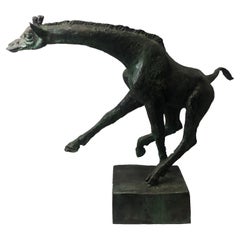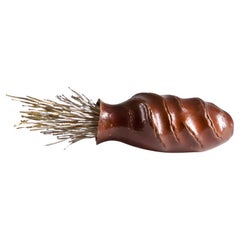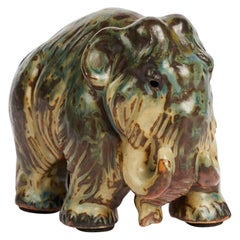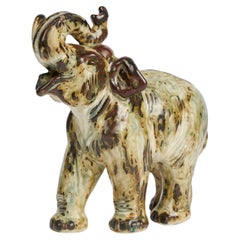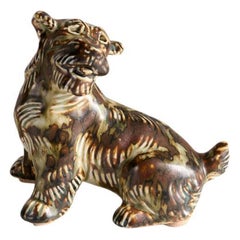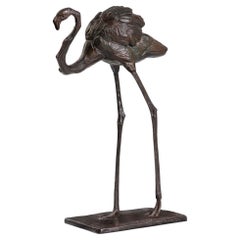New York Animal Sculptures
to
83
946
90
21
29
188
729
111
117
314
143
22
6
20
28
25
34
93
70
28
7
125
47
33
33
31
18
11
11
10
8
5
5
4
3
3
1
1
476
256
220
175
151
1,057
5,394
5,004
437
133
127
123
118
Height
to
Width
to
1,057
1,044
1,051
21
9
7
7
6
Item Ships From: New York
Att: Hugo Lisberg, Striding Giraffe, Dutch Modernist Bronze Sculpture, ca. 1955
Located in New York, NY
ABOUT SCULPTURE
An incredibly graceful depiction of an animal beloved by everyone in the interpretation of the famous Danish master of the last century, Hugo Liisberg attracts the v...
Category
1950s Danish Mid-Century Modern Vintage New York Animal Sculptures
Materials
Bronze
Emiliano Céliz, Genesis Marina IV: Life from the Void, Argentina, 2022
By Emiliano Céliz
Located in New York, NY
Emiliano Céliz is one of the finest silversmiths in South America. Residing in the San Martin de los Andes of Patagonia, he takes as his inspiration the splendor of his natural surroundings, incorporating the forms found in the beautiful lakes and the exquisite landscapes of the region into his work. His decorative artworks are wrought from a single plate of metal, a technique mastered by only a few artists in the world.
Evocative of primitive life in ancient seas...
Category
2010s Argentine New York Animal Sculptures
Materials
Copper
Knud Khyn for Royal Copenhagen, Small Ceramic Mammoth, Denmark, circa 1920
By Royal Copenhagen, Knud Kyhn
Located in New York, NY
This naturalistic and dynamic mammoth was designed by Knud Kyhn who worked for Royal Copenhagen for much of his career.
Incised with signature: KK
Marked with triple waves
Stamped:...
Category
1920s Danish Vintage New York Animal Sculptures
Materials
Stoneware
Knud Khyn for Royal Copenhagen, Ceramic Elephant, Denmark, circa 1960
By Royal Copenhagen, Knud Kyhn
Located in New York, NY
This naturalistic and dynamic elephant was designed by Knud Kyhn who worked for Royal Copenhagen for much of his career.
Incised with signature: KK
Marked with triple waves
Stamped...
Category
1960s Danish Vintage New York Animal Sculptures
Materials
Stoneware
Knud Khyn for Royal Copenhagen, Ceramic Terrier, Denmark, circa 1950
By Royal Copenhagen, Knud Kyhn
Located in New York, NY
This naturalistic and dynamic terrier was designed by Knud Kyhn who worked for Royal Copenhagen for much of his career.
Numbered 20129. Incised KK.
Category
1950s Danish Vintage New York Animal Sculptures
Materials
Stoneware
Rembrandt Bugatti "Flamant en Marche" Bronze Sculpture
By Rembrandt Bugatti
Located in New York, NY
Rembrandt Bugatti's "Flamant en Marche" also known as "Walking Flamingo" features a flamingo standing on two legs, a classic pose that highlights its slender, S-shaped neck and delic...
Category
Early 20th Century New York Animal Sculptures
Materials
Bronze
Rembrandt Bugatti "Jabiru Femelle" Bronze Sculpture
By Rembrandt Bugatti
Located in New York, NY
In this statue "Jabiru Femelle" also known as "Female Saddle Billed stork", the stork wades carefully through the water, its long, slender legs moving with quiet determination. The s...
Category
Early 20th Century New York Animal Sculptures
Materials
Bronze
Rembrandt Bugatti "Panthère assise" Bronze Sculpture
By Rembrandt Bugatti
Located in New York, NY
In "Panthère assise" also known as "Seated Panther," Bugatti seems to have been concerned primarily with musculature. The uneven surface exaggerates the contours of muscles which in turn causes a curious effect: weightiness from the amplified muscles and lightness created by the myriad reflecting planes. Bugatti’s sculpture relies on asymmetry, with nearly half of the composition occupied by the panther’s horizontally extended tail. The curve of the tail rises, flowing into the S-shaped arc of the panther’s movement, accentuating the dynamic form of the great cat.
Product Details:
Item #: B-21648
Artist: Rembrandt Bugatti
Country: France
Circa: 1912
Dimensions: 8.625" height, 4.625" width, 14.25" depth.
Materials: Bronze
Signed: R. Bugatti and incised 1 with foundry mark Cire Perdue AA Hébrard
Documentation: According to the Répertoire monographique, ten numbered casts of this model are known to exist.
Provenance: M. Maire Collection, Épinal (acquired directly from Galerie A.-A. Hébrard, Paris in 1912)
Literature: P. Dejean, "Bugatti, Carlo-Rembrandt-Ettore-Jean", Paris, 1981, p. 155 (another cast illustrated). J.-C. des Cordes & V. Fromanger des Cordes, "Rembrandt Bugatti, Catalogue raisonné", Paris, 1987, p. 47 (another version illustrated). E. Horswell, "Rembrandt Bugatti, Life in Sculpture", London, 2004, p. 143 (another cast illustrated). V. Fromanger, "Rembrandt Bugatti Sculpteur, Répertoire monographique, une trajectoire foudroyante", Paris, 2009, no. 294 (another cast illustrated p. 328). A. Daemgen & P. Demandt (eds.), "Rembrandt Bugatti, The Sculptor 1884-1916", Berlin, 2014, p. 118 (another cast illustrated). V. Fromanger, "Rembrandt Bugatti Sculpteur, Répertoire monographique, a meteoric rise", Paris, 2016, no. 298, (another cast illustrated p. 363).
Macklowe Gallery Curator's Notes:
Bugatti’s panther...
Category
Early 20th Century New York Animal Sculptures
Materials
Bronze
Rembrandt Bugatti "Ours Brun Marchant, La Patte Droite en Avant" Bronze Sculptur
By Rembrandt Bugatti
Located in New York, NY
Bugatti’s "Ours Brun Marchant, La Patte Droite en Avant" also known as “Brown Bear Walking,” depicts a bear mid step in a relaxed position, on all fours, as if calmly surveying its s...
Category
Early 20th Century New York Animal Sculptures
Materials
Bronze
Rembrandt Bugatti "Panthère au repos" Bronze Sculpture
Located in New York, NY
In the "Panthère au repos" also known as "Panther in Repose", Bugatti seems to have been concerned primarily with musculature. The uneven surface exaggerates the contours of muscles which in turn causes a curious effect: weightiness from the amplified muscles and lightness created by the myriad reflecting planes. And while this cat is sculpted in movement, it has a posed appearance.
Product Details:
Item #: YB-21615
Artist: Rembrandt Bugatti
Country: France
Circa: 1904
Dimensions: 7" height, 14.75" width, 5" depth.
Materials: Patinated Bronze
Signed: R. Bugatti and incised 10 with foundry mark Cire Perdue AA Hébrard
Literature: V. Fromanger, "Rembrandt Bugatti, sculpteur, une trajectoire foudroyante, répertoire monographique, les éditions de l'amateur", Paris, 2016, p. 179 pour le plâtre, p. 356, no. 214.
Macklowe Gallery Curator's Notes:
Bugatti’s panther...
Category
Early 20th Century New York Animal Sculptures
Materials
Bronze
Rembrandt Bugatti "Storks at Rest" Bronze Sculpture
By Rembrandt Bugatti
Located in New York, NY
Rembrandt Bugatti's striking bronze depicts a pair of elegant white storks. The male stork, positioned on the left, gently rests its head upon its soft breast while tucking one of it...
Category
Early 20th Century French Art Nouveau New York Animal Sculptures
Materials
Bronze
Mellerio Paris, A French Gold, Diamond, Silver-Gilt, Rock-Crystal, & Lapis Horse
By Mellerio
Located in New York, NY
Mellerio Paris, A French Gold, Diamond, Silver-Gilt, Rock-Crystal, Obsidian & Lapis Horse
An extremely rare and unique, one of a kind French gold, diamonds, Silver-gilt rock-crystal, obsidian and lapis lazuli jeweled sculpture "Bucéphale, Chevaux de légende", "Bucephalus, A Legendary Horse" by Mellerio, Paris, circa 1998.
Sitting on black obsidian base, the solid rock crystal slab is finely applied with a lapis lazuli half-horse with harness mounted in 18k gold and brilliant cut diamonds, between two crystal and lapis lazuli columns adorned with gold and diamonds, insert with 7 ruby cabochons and 1 emerald cabochon, the obsidian base with a plaque engraved: CHEVAUX DE LEGENDE / MELLERIO DITS MELLER / PARIS / 5029 DIV
Bucephalus (c355-326 BC) is among the most famous horses in history, and it was said that this he could not be tamed. The young Alexander the Great, of course, tamed him – and went on to ride his beloved equine companion for many years and into many battles.
The piece is in excellent condition and comes with a custom made wood case made for transport. It's very elegant and has French hallmarks throughout. A truly magnificent piece.
Measures 10" high x 9" wide x 4" deep
Founded in France in 1613 by the descendants of Italian immigrants from the Vigezzo Valley in the north of Italy, Mellerio is one of the oldest jewellery houses in Europe. The family business soon attracted the attention of the Royal Court and Marie Antoinette herself reportedly purchased a precious bracelet featuring 7 cameos surrounded by rubies in 1780. Later on, in the 19th century, Mellerio became the official supplier of the French Royal family and the Court of Netherland.
Mellerio creates many jewellery items, all set with rare gems such as peridots, amethysts, aquamarines, citrines and topaz, applying for a patent, the flexible stem, a very supple and light jewellery mechanism. Mellerio remains also well known for their spectacular series of Art Nouveau jewels, created at the beginning of the 20th century, as well as for the creation of trophies rewarding some of the greatest footfall and tennis players of history. In 1993, the jewellery house launched their first watch collection.
Today, Mellerio has stores in Paris, Japan and Hong Kong.
July 14, 1789: this date is known throughout the world as the beginning of the French Revolution. According to a ledger belonging to House of Mellerio, this was also the day that the jeweler sold a golden key to the Comte de Coutance for 10 livres. This ledger, as well as inventories dating as far back as 1768, are the jeweler’s oldest archives. These archives have continued to grow over the years, as the House, established on rue de la Paix in Paris, still lives on today, still in the hands of the same family from Craveggia, in the North of Italy.
The tumultuous history of the Mellerio family in France probably goes as far back as the Italian wars of the Renaissance, but the first official document proving their commercial activity in Paris dates back to 1613. This document is the famous royal warrant awarded by Marie de Medici to a number of Italian families established along the rue des Lombards, including the Mellerios, allowing them to sell “small jewelery items”, therefore granting them a small exception to the traditional monopoly enjoyed by Parisian jewelers. At that time, powerful corporations regulated the operations and customs of Parisian business, but thanks to this exceptional warrant, the Mellerios managed to escape the confines of this framework. Today, this wax-sealed document is kept at the city hall of Craveggia.
From 1613 to the Revolution, the Mellerios lived between France and Italy. The corporations tried many times to put an end to their trade privileges, but all in vain, as a dynasty of sovereigns renewed the warrant. Always marrying and often retiring in Craveggia, the Mellerios continued to maintain their jewelry business in Paris. At first, they did this without a shop. Wearing backpacks (wooden boxes divided into small compartments where jewels were kept), they would tour town fairs around Paris and royal castles.
This is how Jean-Baptiste Mellerio (1765-1850) is said to have sold a bracelet set with rubies and Antique cameos to Marie-Antoinette, which still exists today. Many elements seem to prove the veracity of this anecdote. The queen was particularly fond of cameos, which cover the entire background of her famous jewelry cabinet, and ruby was her favorite stone after diamond. The famous bracelet, reacquired a few years ago by the House of Mellerio, is indeed an 18th century jewel, set with antique cameos representing the profiles of Roman emperors. Two branches of the family were operating in Paris during this time, under the reign of Louis XVI: that of Jean-François (1746-1828), the paternal ancestor of the current Mellerios, and that of Jean-Baptiste (1765-1850).
The French Revolution forced them to return to Italy. However, both Jean-Baptiste and François Mellerio (1772-1843), who was the son of Jean-François, were eventually able to return to Paris after the founding of the Consulate. Jean-Baptiste opened a shop at the Iron Crown of rue Vivienne, and François opened his at the Palais des Tuileries, rue du Coq Saint-Honoré. His well-organized order books give an idea of his high-ranking clientele during the “Old Regime”, among which were the Comte and Comtesse Octave de Segur, the Marquise (later Duchess) de Tourzel, former governess of the royal children, and her daughter, the Comtesse de Bearn, the Craufurds -who organized the flight to Varennes, the Duc and Duchess de Gramont, the Comtesse de Boigne, and Madame de Souza, Talleyrand’s mistress.
We also see the names of the imperial family: Empress Josephine, the Queen of Holland, Princess Elisa, Caroline and Pauline. At that time, the House of Mellerio specialized, among other things, in the trade of antique cameos, a newly fashionable genre of jewel that captured the imagination of all the princesses and noble women of the time.
The years of the Restauration and July Monarchy were among the most glorious. The Bourbons were back on the throne, and the clientele of the House of Mellerio had regained its former wealth. Mellerio supplied Louis-Philippe, Duke of Orléans, as well as his mother, wife and sister, with sumptuous jewels, including a set of emeralds made piece by piece, while the Duke of Bourbon, last prince of the House of Condé, offered diamonds to his mistress, the scheming Baronne de Feucheres, and Monsieur de LaFayette also bought cameos for one of his granddaughters. For the first time, Mellerio ventured into the world of arts in 1815, when Carlotta Grisi, a famous dancer who created Giselle, as well as an actress named Rachel, bought jewels at the Mellerio store on rue de la Paix.
1848 marked a new turning point. France once again became a Republic. François Mellerio handed the company over to his son, Jean, and the latter decided to travel to Spain to build a new clientele. He later became one of the jewelers of the royal family, and met Eugénie de Montijo, who remained a faithful client when she became empress of the French people. The Imperial years were lavish. During the Second Empire, Paris was a pageant of crinoline dresses designed by Worth, while jewels by Mellerio, Worth’s neighbour on the rue de la Paix, adorned the noble women of the Tuileries court.
The Empress bought pearls. Mathilde Bonaparte...
Category
20th Century French New York Animal Sculptures
Materials
Lapis Lazuli, Rock Crystal, Gold, Silver
Koko Lamp By Barlas Baylar
By Hudson Furniture, Barlas Baylar
Located in New York, NY
Description: Koko lamp
Dimensions: Approximate 24” diameter x 47” height
Material: Solid bronze, linen shade
Finish: Polished, (custom finishes available)...
Category
2010s New York Animal Sculptures
Materials
Bronze
